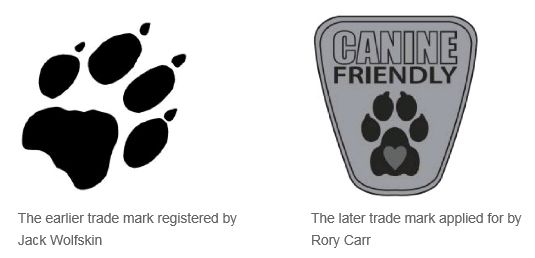Under the company RC Pet Products Limited, Rory Carr trades in a variety of goods for animals, such as collars, coats, harnesses and pet toys. As part of its branding the company uses an image of a paw print, and was surprised to encounter opposition from a well-known company trading in waterproof clothing, tents, and other outdoor equipment for humans. This opposition was one of many initiated by German company Jack Wolfskin in an attempt to assert broad rights to the device of a paw print.

Claiming reputation and a likelihood of confusion, Jack Wolfskin invoked Article 8(5) and Article 8(1)(b) EUTMR and based the opposition on its earlier registrations in the EU and Germany for its paw print device mark. The EUIPO first examined Jack Wolfskin's case in respect of its reputation claim, assessing whether the grounds for refusal under Article 8(5) EUTMR had been met by considering the similarity between the signs, the reputation of the earlier marks in the relevant territory (the EU and Germany) prior to the relevant date in 2011, and whether or not a link would be made.
Though the Office proceeded with its routine practice of placing the burden of proof of the 8(5) defence, due cause to use, onto the Applicant by stating that in the absence of such a claim it had to be assumed that no due cause existed, the application of this principle in the present matter appears somewhat misplaced for two reasons. Firstly, due cause to use owing to the Applicant's commercial field was raised in the Applicant's observations, and was supported by accompanying evidence illustrating the prevalence of the paw print image for traders retailing in pet/animal products. Secondly, even if (as the Office claims) this defence was not invoked and earlier precedent dictates that it must be assumed that no due cause existed, due cause is surely evident where the symbol of a paw print is being used to promote and identify pet-related products. Indeed, the Office seems to admit that the Applicant would have a reason to use the image when its consideration of the distinctiveness of the marks later on in the decision led to its conclusion that "the depiction of an animal's paw print [is] often used in the field of pet accessories".
When assessing the similarity between the signs, the Office concluded that the presence of the paw print in the Applicant's mark "will be perceived as a mere indication that the relevant goods are for animals" and as such the marks were deemed visually and conceptually similar to a low degree, coinciding only in the (weak) figurative element of the paw print. Regarding the distinctiveness of the earlier marks, the Office asserted that the distinctiveness of Jack Wolfskin's trade mark can be attributed to its "very specific configuration", i.e. tilting to the right.
In view of Jack Wolfskin's prominence in the field of outdoor apparel and equipment for humans, the Office was able to find that it did have a reputation for such goods based on the voluminous evidence submitted by the Opponent, including e.g. a witness statement covering the high turnover in Germany, financial spending details, catalogue excerpts, and studies regarding consumers' awareness of the brand in Germany. Interestingly, the evidence submitted led the Office to conclude that Jack Wolfskin's marks enjoyed a reputation in Germany, which was considered sufficient to establish a reputation in the EU owing to the size of the German market in respect of outdoor products being "sufficient to include a substantial part of the European Union as relevant territory". This is good news for brands with a loyal following in Germany, and indicates that the Office's position regarding the significance of the German market, which has been referenced before in cases involving proof of use of earlier marks, also extends to cases involving reputation of a trade mark.
Nevertheless, a reputation could not be proven in respect of the broad range of goods covered by Jack Wolfskin's earlier marks which, at the relevant date, spanned from USB sticks, to advertising consultancy, to transport. It is also worth noting that, despite the German mark it was relying on covering animal-related products, Jack Wolfskin partially surrendered its registration in respect of all such goods midway through the proceedings following the filing of a cancellation action against this German mark by a third party (notwithstanding the restriction, Jack Wolfskin maintained its opposition against Rory Carr's pet-related goods). Even following this surrender, the Office could not establish that a reputation existed for all of Jack Wolfskin's goods, merely those that pertained to outdoor products (such as bags and backpacks in Class 18, sleeping bags in Class 20, tents in Class 22, clothing in Class 25, camping mats in Class 27, and bags adapted for sporting equipment in Class 28). Jack Wolfskin was unable to prove that its reputation extended beyond such goods, which echoes the outcome of previous cases where it has relied on reputation. Indeed, the Office stated that brand extension from humans to animals is not common practice, suggesting that, in comparing these two commercial spheres of products, the mental link threshold when examining an Article 8(5) claim is particularly high. The case was also instructive as to the Office's perspective on 'Amazon' evidence, submitted by Jack Wolfskin in support of its assertion that these sectors are linked. The Office indicated that limited value is attributed to evidence of this kind, arguing that such outlets sell a wide variety of goods and so the mere fact that two products are both being sold via this outlet is not sufficient to find that there is a link between them.
For the pet-related goods being applied for, the Office concluded under Article 8(5) that Mr Carr's trade mark is unlikely to bring Jack Wolfskin's earlier marks to mind owing to the dissimilarities between the goods for which reputation was shown and the weakness of the paw print element within the context of pet-related goods. Regarding the 8(1)(b) claim, the Office found no likelihood of confusion, even where there was some identity and similarity of goods, in view of the insufficient similarities between the marks. Further, the inclusion of the verbal element "CANINE FRIENDLY" in Mr Carr's mark means that it is by this wording that the relevant public is most likely to perceive and remember the later sign.
This was a David and Goliath-type dispute, with a relatively small Canadian business facing a well-established organisation with significant financial resources. However, following its loss here (as well as other losses in the EU and elsewhere), it will be interesting to see if Jack Wolfskin continues with its broad objections to the use by others of a paw print. The stone between the eyes for Jack Wolfskin in the present case was an inability to show that its reputation extended as far as pet products, combined with a weak position in preventing the paw print image from being used in wholly justifiable contexts.
The content of this article is intended to provide a general guide to the subject matter. Specialist advice should be sought about your specific circumstances.


